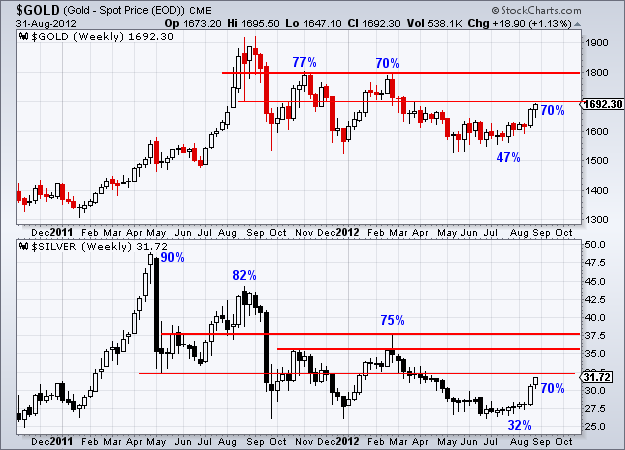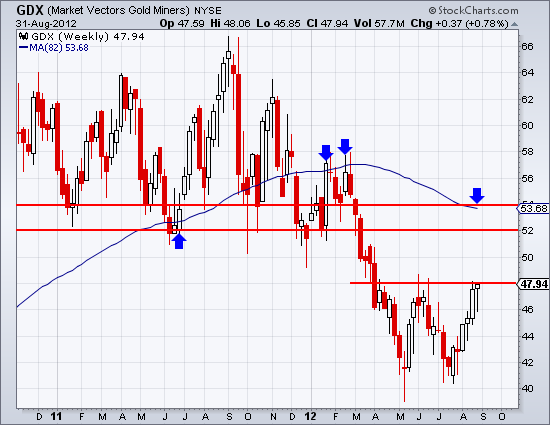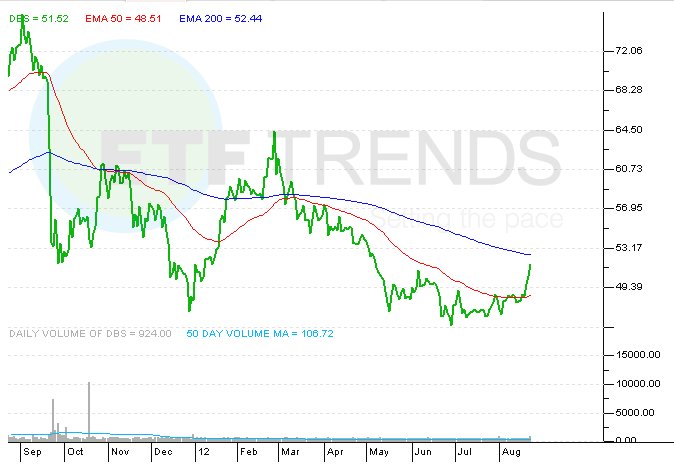In the Investor Alert, our investment team shares charts and data that we believe provide readers with a first mover advantage. While markets don’t always move like we anticipate, recognizing historical trends can provide an edge if you act quickly.
Last week, gold bugs were rewarded with the long-awaited positive momentum in the yellow metal, and on Friday, bullion rose to about $1,670. After falling below the 200-day moving average, gold had been stuck in quicksand for several months. With the jumps in the price last week, bullion swiftly rose above this critically important long-term moving average.

Bloomberg reported on Thursday that gold investors were the “most bullish in nine months” as its survey of 29 of 35 analysts indicated that they expected prices to rise—only three were bearish toward the metal.
One chart that might turn those three bears to gold bulls was featured in a recentInvestor Alert. I noted that gold’s 12-month rolling return in standard deviation terms triggered an extremely low sigma event, dipping below a reading of -2. To our investment team, this signal means that investors should expect gold to experience a significant price reversal.

Price reversals, of course, work both ways—the oscillator above also tells you whether gold has climbed too quickly and should be expected to fall. If you take a look at the previous “peak,” when gold rose above 2 sigma, the chart sent out a chilling warning signal that gold was due for an eventual correction.
Last August, when the price of gold was reaching all-time highs, I reminded investorsthat it would be a non-event to see gold decrease by 10 percent. In fact, I felt that this correction would be a healthy development for markets, because it would act to remove the short-term speculators while the long-term story remained on solid ground.
Gold still hasn’t made it back to its all-time high, but Stifel Nicolaus’ gold-to-crude oil ratio suggests gold climbing to $1,900. According to Stifel’s research, the gold-to-oil ratio based on the price of Brent has historically “shown a tendency to run to around 16.5x.” In other words, the price of the yellow metal is usually about 16.5 times the price of a barrel of Brent oil. With Brent trading around $116 per barrel last week, the math tells us that gold could go to $1,900.

The long-term fundamentals for gold stand on solid ground. Way back in March, Ian McAvity stated that the “extreme behavior of major central bankers and the absurd ‘risk-on/risk-off’ surges of liquidity across all markets fueled by those liquidity injections sloshing around markets rather than reaching any economy is frightening, and the most bullish fuel they could throw at the gold market.” Liquidity keeps flowing today, as central banks have continued their massive global easing cycle throughout the summer. In McAvity’s opinion, “The gold price volatility is more a reflection on the U.S. dollar and euro paper and the madness of an asset bubble. Gold will be the last man standing on the other side of the valley.”
Even the Love Trade—gold buying out of China and India—isn’t over, despite rather tepid quarter-end results from the World Gold Council. In his latest Greed & Fear document, Christopher Wood from CLSA says that he believes the media overreacted to China’s gold demand. With gold demand totaling nearly 800 tons from June 2011 to June 2012, he points out that the country “is still buying a lot of gold.”
As for gold demand in India, his team hears that people are buying gold with cash to avoid the higher duties. “As a result, these cash purchases will not be recorded in the official data,” says Wood.
In addition to these factors, there’s a new growing demand coming from central banks. Wood sums it up for investors: “The conclusion for investors is stupefyingly simple. Stay long gold.”
U.S. Global Investors, Inc. is an investment management firm specializing in gold, natural resources, emerging markets and global infrastructure opportunities around the world. The company, headquartered in San Antonio, Texas, manages 13 no-load mutual funds in the U.S. Global Investors fund family, as well as funds for international clients.
For more updates on global investing from Frank and the rest of the U.S. Global Investors team, follow us on Twitter at www.twitter.com/USFunds or like us on Facebook at www.facebook.com/USFunds. You can also watch exclusive videos on what our research overseas has turned up on our YouTube channel atwww.youtube.com/USFunds.
All opinions expressed and data provided are subject to change without notice. Some of these opinions may not be appropriate to every investor. Standard deviation is a measure of the dispersion of a set of data from its mean. The more spread apart the data, the higher the deviation. Standard deviation is also known as historical volatility.





















